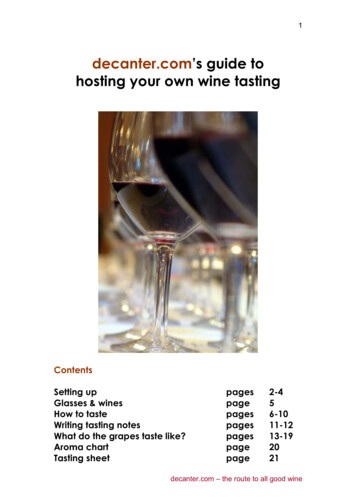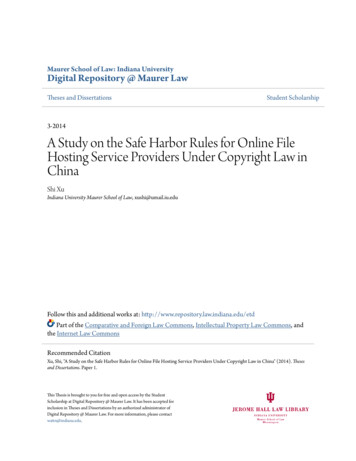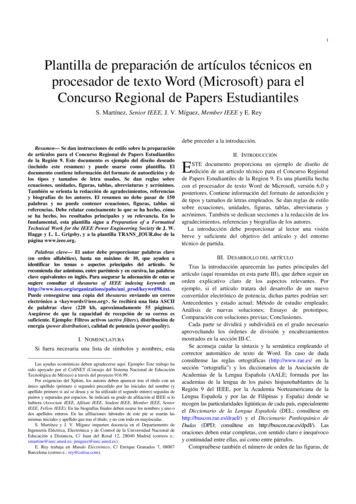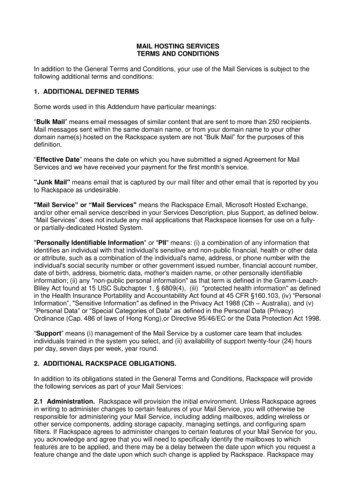
Transcription
1decanter.com’s guide tohosting your own wine tastingContentsSetting upGlasses & winesHow to tasteWriting tasting notesWhat do the grapes taste like?Aroma chartTasting 13-192021decanter.com – the route to all good wine
2decanter.com’s guide to hosting your own wine tastingThis is our quick and easy guide to setting up a wine tasting for friendsand family. You will have to provide your own wine but this smallpackage should cover the rest.This pack contains: The guide to hosting a wine tasting The grape varieties guide A tasting guide An aroma chart A Decanter tasting note sheetGetting startedFirst of all, select and buy your wines (these can be your own personalpreferences or some bottles you’ve never tried before). You can useour list of wine choices for inspiration or as a guide in choosing bottles.What you will need: A good table A spittoon (optional) Paper, pens and a tasting sheet (see p.?) A sink 1 glass per personTypes of wine tastingThere are several different ways of organising a wine tasting and thesewill affect the wines you buy: COMPARATIVE TASTING. This is a tasting in which you and your gueststaste three or more examples of a particular grape or style (forexample, tasting 3 bottles of Cabernet Sauvignon, one fromCalifornia, one from Australia and one from Bordeaux). TASTING BY VARIETIES. This is amix of grape varieties,vintages and styles,starting with the whitesand ending with the reds,going from the leastpowerful grape to themore perfumed and fullbodied, and going fromthe youngest to the oldestvintage. Our guide towine tasting lists the orderdecanter.com – the route to all good wine
3of grape varieties and styles. This is the type of tasting we do atDecanter for our Wines of the Month recommendations. HORIZONTAL AND VERTICAL TASTINGS. These are at the moreprofessional (and therefore more costly) end of the spectrum.a) A horizontal tasting compares wines from a specific regionand vintage. Most Decanter panel tastings are horizontal.b) A vertical tasting compares the wines of one estate orproducer. This will show the evolution of the wine and the effectdifferent growing conditions have on the production of a wine.Once you have decided on your tasting, assemble your wines andrefrigerate them if necessary. Sparkling and white wines should berefrigerated, but not for too long. Allow refrigerated wines a little timeout of the fridge to warm as most refrigerators are too cold for wines(aim to serve them at around 10-14oC). Reds should be stored in a coolcellar (ideally) and served just below room temperature (aim for 18oC).Blind tastingIt is always more interesting to serve wine blind. Not only does coveringthe bottle remove any prejudice attached to a particular wine, it alsoallows beginners, amateurs and experts alike the chance to rate thewine on a level playing field – that of pure taste. This gives beginnersmore confidence to analyse a wine in the company of others.You can cover thebottle with a smallopaque bag or prepour the glasses beforeyour friends arrive. Obviously, pre-pouring will change the temperatureof the wine if it sits in the glass for an extended period of time. Revealthe identity of the wines when your friends’ curiosity has peaked or, asthe host, you can play the options game (see below).The Options GameLen Evans OBE is credited with having invented this game, in which playerscompete to guess, eventually, the name, grape variety and vintage of a wine. Thehost starts off by asking very general questions such as ‘is this an Old World orNew World wine?’, gradually getting more precise, asking for a guess of thevintage (‘is it pre-2000 or post-2000’) and whether or not the wine is CabernetSauvignon or Pinot Noir. Those giving the wrong answer in each round areeliminated from the game until the producer and year (and possibly grape variety)has been correctly deduced or until there is no one left in the game.decanter.com – the route to all good wine
4Your friends can exchange their thoughts on smell and taste as theytaste the wines or, no less convivial although slightly more academic,your tasters can take down notes (use our tasting note sheet) andcompare them after each wine or collection of similar wines (known asa ‘flight’).It’s good to spitDecanter consultant editor Steven Spurrier, regularly tastes a large number ofwines at tastings.'I get pretty light-headed,' he says. 'I can see by the quality of my handwritingbetween note 1 and note 100 that it's had an effect.'FoodFoodAlthough wine and food matching is a vast and varied topic in itself, itis worth thinking of a few matches. It is always worthwhile breaking for asmall meal or snack. Having a good supply of crackers or any otherneutral-tasting snack to cleanse the palate throughout tasting wine isworth the investment.Try thinking of a few cheeses to match the wines. Hard cheeses(Gruyere or Cheddar), blue cheeses (Stilton, Roquefort or Gorgonzola)and creamier varieties (Pont l’Eveque, Camembert or Brie) go downwell at the end of a tasting – often while sipping a glass of yourfavourite of the evening.Other favourites include quiche, ham, saucisson, salad and, aparticular favourite of Decanter’s consultant editor Steven Spurrier,pork pies.Members of the Decanter World Wine Awards Australian panel take a lunch break(from left, Steve Daniels, Matt Skinner, Bill Baker, Michael Hill-Smith MW, Joelle Marti and David Gleave MW)If you want more information on all aspects of learning about wine,don’t forget, decanter.com’s Learning Route(http://www.decanter.com/learning/) is a comprehensive guide foranyone wishing to know more about wine and wine tasting.decanter.com – the route to all good wine
5GlassesGlasses can make all the difference to yourappreciation of a wine. Smell plays a major role inwine evaluation - it is the first sniff of a wine, ratherthan its taste, that gives the best indication of grapevariety. The size, shape and type of glass candramatically affect your tasting by enhancing yourability to pick up aromas and colours.The best glasses are tulip-shaped with a stem. Theglass should enable you to swirl a small sample of winevigorously, allowing the wine to ‘open up’.Getting the wine to ‘breathe’ releases its aromas. Toshow what a difference this can make, pour a sampleand sniff it. Then swirl the wine for about 30 secondsand smell it again. The difference should be apparent– the smell is stronger and it is easier to pick up morearomas.The glass should also be clear, enabling you to judge the colour of the wine.Not all glasses need be as expensive as the 12 Riedel Chianti (pictured above), thestandard glass that we use at Decanter for all our tastings. The perfect tasting glass isthe ISO standard 21.5cl glass, suitable for red, white and sparkling wines as well asfortified and distilled. A box of six costs about 13, available from wine merchants andon the internet. Otherwise, major supermarkets sell decent ranges of cheap butpractical glasses.If you’re tasting sparkling wine, remember flutes are the best shape. Never go for thewide, flat champagne ‘coupe’ - the bubbles dissipate too quickly and the glass doesnot retain the aroma of the wine.In most cases, including sweet and fortified wines, a tulip-shaped glass will do.WinesHere are a few suggestions as to which wines to serve at your tasting.Budget – go for three Chardonnays: one Australian, one American and one French(ie Chablis) and three Cabernet Sauvignons: one Australian, one South African andone French (mainly Bordeaux, but not always). All of these should be available atyour local supermarket where, even if Chardonnay is not represented by threedifferent countries, alternatives such as three Sauvignon Blancs or three Merlotsshould be available.Advanced – try pairing off less well-known varieties such as two Rieslings (oneAustralian, one German); two Sauvignon Blancs (one New Zealand, one French –Sancerre); two Pinot Noirs (one North American, one French – Burgundy); two Merlots(one Chilean, one French – most vin de pays will state the variety on the label or trySt-Emilion)and compare two sweet wines such as a Hungarian Tokaji and an ItalianVin Santo or French Sauternes. Obviously, it will be tougher to pair off certain grapevarieties between countries. Grapes like Tempranillo or Sangiovese (in Rioja andChianti respectively) are harder to find from other areas of the world.Exclusive – Taste several vintages of the same wine. You will more likely need the helpof a wine merchant for this.decanter.com – the route to all good wine
6How to tasteTaken from ‘How to taste’ on decanter.com by Jim Budd & Natasha te.php)Mastering the art of tasting, although oftenconsidered a purely academic exercise, isessential in order to get the most out of your winedrinking.As time goes by and you gain more experience,you will grow more confident in your assessmentof the wines you taste. Some people have aremarkably good memory for tastes, and cansometimes even pinpoint the origin of a wine aswell as the variety of grapes that have been usedto make it.The important thing to remember is that anyone can be a good taster, as long asthey have an unimpaired sense of smell and taste, and are prepared to concentrate.The ideal conditions for tasting are easy - a quietroom and good lighting. The glasses should, ofcourse, be clean, and of the correct shape toallow you to indulge fully in both the aroma andtaste of the wines.If you are making notes, keep them – this willprovide you with an invaluable source ofreference when it comes to buying wines.Professional tasters keep their notes for years –Bordeaux expert David Peppercorn has tastingnotes going back to the late 1950s.Not all tasting rooms are as ideal as those ofthe Decanter World Wine AwardsWrite notes'Keep a notebook, with at least the names, producers’ names and vintages ofevery wine you try. Write at least a brief note on each one – even a simple wordsuch as “sharp” or “heavy”: it records your real reaction. Adding your own versionof Decanter’s five-star system is a good idea too. If you add the names of yourcompanions and what food you ate it with, it will be a long book – but far moreinteresting.’ Hugh JohnsonAppearanceApart from the fact that our appetites arewhetted by the anticipation of what is to come,looking can also tell us an awful lot about whatwe're about to put in our mouths. You should tipthe glass away from you at an angle of 45degrees and hold it against a white background a piece of white paper is fine - to see the truecolour of the wine.Perhaps the most obvious characteristic of wine isits colour. Is it white, red - or a rose? HavingMiles and Jack study the appearance of awine in the film Sideways – image courtesyof Twentieth Century Foxdecanter.com – the route to all good wine
7determined the basics, take a closer look. The colour of your white wine could rangebetween pale straw and rich golden yellow, depending on its age, its sweetness, itsdegree of oakiness and, of course, the grape variety from which it was made. As arule, lighter wines such as Sauvignon Blancs tend to be paler than heavierChardonnays, and the gold tinge of an aged Chardonnay will be more pronouncedthan that of a younger one.Red wines can also be analysed in a similar way. The deeper the colour, the moreconcentrated the flavour. Stand a glass of Pinot Noir next to a glass of Syrah and youwill easily see the difference between the two - the Pinot will be an almosttransparent light ruby red, while the Syrah will verge towards a dense purpley red. Amouthful from each glass is bound to confirm the visual impression. Tilt the glass a littleand take a look at the meniscus (the curved upper surface and rim) of the fluid - as ared wine ages, it will take on an amber-brown tinge, and this is most easily discernibleat the rim.As you tip your glass back towards you, you may notice clear traces of liquid stickingto the side of the glass as they slide slowly back into the body of the wine - these arecalled tears or legs, and indicate high alcohol or residual sugar content.Finally, looking at your wine will give you advance warning of any major defects - ifyou find white filaments floating in your wine, reject it outright as these are almostcertainly present due to unclean bottling.SmellThe sense of smell and the sense of taste are soclosely intertwined that one could not exist withoutthe other. For this reason, your nose can tell you agreat deal about a wine before you even taste it.A properly designed glass can help capture a wine'saromas and funnel them in the right direction. Whileglasses intended for use with reds tend to have aA guest at one of our Fine Winelarger bowl than those made for whites, both typesEncounter Masterclasses noses a wineshould taper towards the top, 'steering' the bouquettowards your nose rather than allowing it to dissipatefrom a large surface area. Swirl the wine in the glass so that most of its interior surfaceis coated in liquid as this helps to release the wine's aroma. Put your nose well into theglass and sniff.As with the colour of a wine, its perfume will vary according to its age andcomposition. The region where it was made can also influence its aroma, as canageing in oak barrels. Think about the smell. Is it powerful and complex or simple andlight? Does it linger or is it soon dissipated?Grape variety has a profound influence on a wine's perfume. The aroma ofSauvignon Blanc, for instance, is classically described as 'cat's pee on a gooseberrybush', Cabernet Sauvignons are often characterised as having a blackcurrant qualityand Pinot Noirs have something of the barnyard about them.As a wine ages, its aroma may change - white wines often become more honeyedover the years, while young whites are often described with reference to fresh flowers,fruit or newly cut grass.decanter.com – the route to all good wine
8A good sniff will also give you clues about a wine's condition - if it is corked it will smellmusty. A whiff of burnt matches is the hallmark of a wine to which sulphur has beenadded as a preservative (quite common in cheap white wines). An oxidised wine willbe given away by a rich burnt scent, similar to that of Madeira (an additional cluecomes with looking at an oxidised wine, which usually appears brownish in colour).Be as poetic as you want in your evocation of a wine's bouquet and haveconfidence in your ability to judge its qualities. After all, there is no right or wrong inanyone's description of a wine - it is just a highly personal reaction to the scentreleased from the glass.TasteImportant as the senses of sight and smell arewhen it comes to our enjoyment of a wine, theultimate test is its taste. Take a mouthful of theliquid and swish it around in your mouth quitevigorously. Breathe as you do so, as this helps toaerate the wine and increases its flavour. Afterholding the wine in your mouth for 15 to 20seconds, spit it out - or swallow it if you're notintending to taste more than a couple of wines.Your tongue has a range of taste receptors indifferent places - you will taste sweetness most atthe front, acidity along the sides and bitterness atthe back. High acidity will make your mouthwater, while tannin (which tends to be mostpronounced in young red wines intended for longcellarage) will have the opposite effect.James Lawther MW, one of our BordeauxWhen you evaluate the wine, first take intoexperts, about to taste a St-Emilion at theDecanter World Wine Awards this yearaccount its complexity and weight. Again, thesequalities will depend on many factors, includingthe grape varieties used and the age of the wine: a fine aged Bordeaux will be fardenser than a young Beaujolais.Certain characteristics are associated with the various types of grape and even withthe area where a wine is grown - an Australian Riesling might be described as havingtropical fruit flavours, while a Riesling from Alsace would be lighter and have a moremineral/citrus quality.In Old World wines, certain grape varieties tend to be associated with particularareas. One could say with a reasonable degree of certainty that a wine made fromPinot Noir grapes probably comes from Burgundy. This is now increasingly the case inthe New World as well. Marlborough in New Zealand, for example, is nowconcentrating white wine production on its famed Sauvignon Blancs.There is no right or wrong conclusion to be drawn about any individual wine. Describeit according to your own perception - after all, tasting is meant to encourage you tocreate your own frame of reference for the wines you drink. Learn about the tastesthat you enjoy - and those you don't - then follow the instincts that you havedeveloped when it comes to buying wine in a restaurant or for drinking at home.decanter.com – the route to all good wine
9AssessingAfter you have sampled a wine with your eyes, nose and mouth, you will then be in aposition to assess it. Is it simple and easy to drink or is it complex, with many differentlayers of flavours that will reveal themselves overtime? Is it ready for drinking now or should you keep itfor a while? Does it offer value for money? Mostimportantly, do you enjoy it?A wine that gives immediate pleasure and doesn'thave any tannins that need to soften is ready to drink.If a red has a lot of tannin, then it may well needseveral years to soften and to show its best. A winethat feels closed or tight at the back of the palate willgenerally improve with time. Some young wines that taste very oaky, especially if theoak and the fruit seem separate, may just need time for these elements to marrytogether.One of the continuing fascinations of wine lies in determining when it will be ready todrink. The optimum moment depends upon the individual drinker - some enjoy theirwines young, when the fruit is to the fore, others prefer to wait until the wine hasdeveloped the richness that is characteristic of age.Whatever your budget, getting value for money isvery important. Even if a wine costs 2.49 (US 3.70), it'stoo expensive if it disappoints. A poor wine at 25.99(US 39) will be much more painful. Naturally, it isdifficult to disentangle value for money fromreputation, but past experience and a bit of researchshould help you to find your way through the maze ofpossibilities.Fortunately, taste is very individual. We don't all like or appreciate the same thingsand everyone has different flavour associations. Of course, it is worth taking accountof what established critics such as Oz Clarke, Malcolm Gluck, Robert Parker andJancis Robinson say, as they taste a vast range of wines and their pronouncementscarry the weight of experience. But as far as you're concerned, the most importantassessment should be your own.FaultsThere are several wine faults. Most come from poorwinemaking or from defective materials, especiallycorks. Faults vary in intensity - some merely lessening thepotential pleasure from a bottle, others making itundrinkable.Not all tasters are equally sensitive to particular faults some notice a corked wine in seconds, while othersmay pick up on too much sulphur.Judging by the expressions, Oz Clarke andBill Baker have found one they don’t likedecanter.com – the route to all good wine
10Main faults: Corked - the wine smells and tastes musty and sour. Caused by a fault in thecork whereby a chemical called TCA destroys the wine.Oxidised - a wine that has had too much contact withoxygen. It has a sherry-like smell. Oxidised white wine iscuriously dark in colour for its age while red is abnormallybrown for its age. All wines gradually oxidise as they getolder. This is an essential part of the ageing process.However, some wines are prematurely old. This may bedue to poor handling of the grapes after they have beenpicked, faults in the winemaking or because the cork hasprovided an imperfect seal.Over-sulphured - a wine that smells of burnt matches andleaves a sour taste in the back of the throat. It will oftenleave you with a foul headache the next morning. Sulphur dioxide is widelyused as a necessary 'disinfectant' in wine-making. Many winemakers now,however, try to use as little sulphur as possible. Today sulphur levels aregenerally much lower than they were twenty or thirty years ago.Hydrogen-sulphide - bad egg smells that come from winemakers not payingsufficient attention during fermentation. Equally, they can occur if the winehas not been racked adequately while it matures.Unclean barrels ('barrel taint') - can give wine an unpleasant musty tastewhich is often very similar to a corked wine. Barrels, especially any that areempty for a while, have to be kept scrupulously clean to avoid tainting thewine. Where possible winemakers prefer to keep their barrels full with wine.Acetic acid - common to all wines. In excess it will make the wine smell andtaste vinegary.Don’t take it too seriously though ‘Don’t over analyse,’ says Karen Cakebread of Cakebread Cellars in Napa.‘Wine is meant to be enjoyed with yummy food and great friends, and whendone so, it always tastes good.’decanter.com – the route to all good wine
11How to write tasting notesTaken from Tasting Notes and how to read them on ingnotes.php)Believe it or not, there is a certainmethodology to writing a tasting note.Generally speaking, the note followsthe process of analysing appearance,smell, and taste, finishing with anoverall appraisal of the wine.You can rate the wine on a star systemor a points system – both have theirchampions (Robert Parker, the hugelyinfluential American wine critic scoreshis notes out of 100; Jancis Robinsonscores her wines out of 20; and ourDecanter tasters score wines out of 20 although the note is represented in star form –five stars being a top-notch wine).Michael Broadbent’s tasting notesThe UK’s most revered taster, Michael Broadbent, has written more than 88,000tasting notes since 1952.‘The best advice I ever received was from Tommy Layton when I joined Layton’swine merchants as a keen but totally ignorant trainee. He told me to make a noteof every wine I tasted: its name, date of tasting, and price, with notes onappearance, nose and taste.‘Why make notes? As an aide-memoire, to familiarise oneself with themultitudinous variety of wines, districts, qualities and styles. And, of course, torecord one’s own impressions briefly or in detail.’Here are two tasting notes (one white wine, one red) we’ve deconstructed to giveyou an insight into the methodology of writing your own. See the Aroma Chart(below) for more help in writing your own.WhiteMeursault 1998 Louis LatourClean, limpid medium yellow with a hint of green, quite rich, a really lovely colour.Touch of new wood on the nose, ripe melony fruit, slightly exotic, stylish and veryexpressive. Fine, floral, honeysuckle fruit on the palate, with hazelnut overtones,rich and quite buttery, yet good lemony acidity, very elegant but still young. Verygood balance, oak and fruit well blended in, an excellent example of grapevariety dominated by terroir, great persistence, very good future.Limpid - Literally transparent, like clear water, while retaining its colourRich - Showing ripeness and viscosity, usually from the legs or "tears" that form on thesides of the glass than from depth of colourNew wood - The vanilla-vanillin aroma of new oak, whether French or Americandecanter.com – the route to all good wine
12Melony - Signifies ripe, slightly exotic fruit, usually referring to Chardonnay. More exoticfruits could be pineapple, guavaExpressive - Expressive of either its grape variety, terroir or both. Stylish expressivewould be a finely turned out wine with characterFloral - Usual on the nose, but on the palate means the blend of florality and flavourHoneysuckle/hazelnut - Typical expressions of a the Chardonnay grown in Meursault,rounded and attractiveButtery - The impression of ripeness with a certain fleshiness, often the result of barrelfermentation or barrel ageingRedValpolicella Classico Superiore 1998 AllegriniBrick red colour, very fresh and young looking. Fine, rose-like like bouquet, somesweetness in attack, drier on the second nose Clean,cherry-like fruit flavours onthe palate, a hint of wood and a touch of bitter almonds , good balance, long,dry finish. Fine long flavour despite the liveliness, natural acidity present, a wine forfoodBrick red - Denotes the absence of violet or purple colours of some very young wines,more a lack of intensity than a sense of maturityRose-like - A delicate aroma, yet with a certain ripeness, always floralAttack - The strong first impression, one that jumps out of the glassSecond nose - The more studied reflection gained by swirling the wine in the glass torelease more than it does on the first impressionCherry-like - Unless cited as 'black cherries' which carry a definite impression ofripeness, cherry-like indicates firm, vibrant fruit with a touch of acidity and none of thesweetness of, say, blackcurrantsWood - A sense of firmness and tannin, as opposed to 'oaky', which refers to the newcasks in which the wine will have been agedBitter almonds - Often associated with cherries, a certain fruity bitterness, morerefreshing than unpleasantFood - Wines with exuberant, unrestrained fruit do not go well with food, for theirfruitiness dominates. A 'food wine' is one that complements a mealdecanter.com – the route to all good wine
13What do the grapes taste like?compiled by Anthony Rose(taken from http://www.decanter.com/learning/grapes.php)More on nearly every grape variety from Aghiorghitiko to Zinfandel can be foundhere: http://www.decanter.com/learning/grapeguide.phpRED VarietiesBARBERA plummy and cherryish undertones of sweet vanillaThe high-in-acid BARBERA grape of north-western Italy is a chameleon-like grapewhich changes considerably according to yield. As an everyday variety, it is a juicyglugger but it can metapmorphose into a concentrated, rich, plummy and cherryishwine with undertones of sweet vanilla and spice when aged in small new oak casks.In Argentina, it tends to the former style with a little less acidity thanks to plentifulAndean sunshine.CABERNET FRANC grassy and raspberryish aroma of lead pencil shavingsCABERNET FRANC, the distant relative of CABERNET SAUVIGNON, can producedeliciously perfumed, supple, raspberry and blackcurrant-infused red wines inBordeaux, while further north in the cooler regions of the Loire Valley and in northeastern Italy, it produces a wine which is more herbaceous in style. It is oftendescribed as having the aroma of pencil shavings.CABERNET SAUVIGNON capsicum and blackcurrant a range of cedar, vanilla and coffeenotesCABERNET SAUVIGNON covers a widespectrum of aromas and flavours. It tendstowards herbaceousness when not fully ripewith capsicum and grassy undertones, butas it ripens it develops flavours ofblackcurrant and, when very concentrated,cassis. In California and Chilean cabernet,you can often spot mint or eucalyptus. Itsaffinity with oak lends secondary characterswith a range of vanilla, cedar, sandalwood,tobacco, coffee, musk and spicy notes.The vineyards of Chateau Latour, providing uswith one of the finest examples of BordeauxCabernet SauvignonGAMAY bubblegum and banana cherry and strawberry flavoursGAMAY, the beaujolais grape, is the gluggiest of all grape varieties, partly because ofthe carbonic maceration or whole berry fementation method used, which helpspreserve the naturally refreshing juiciness of the variety. Carbonic maceration isresponsible for a variety of aromas and flavours ranging from bubblegum andbanana through to strawberry and cherry.decanter.com – the route to all good wine
14GRENACHE white pepper and raspberry thyme and rosemary scentsThe light-coloured GRENACHE is a quintessentially Mediterranean red variety and as aresult it often mingles the classic Mediterranean garrigue scents of thyme, fennel androsemary with white pepper and its warming, raspberryish fruit flavours. It tends to below in tannin and hence soft and supple and, at its apogee in Châteauneuf-duPape, it takes on heady aromas and spicy, robust fruit flavours which can border onthe raisined.MALBEC mulberry and blackberry flavours tarry and leatheryHarsh and rustic in its homeland of south-west France, the MALBEC grape is oftenimproved in Cahors by the addition of the softening MERLOT grape. It really comesinto its own however in Argentina, where it becomes altogether smoother and lusherwith all sorts of plummy, red berry and earthy fruit flavours like raspberry, mulberry andblackberry allied to tar, leather and game-like characters.MERLOT bell pepper and blackcurrant chocolate and spice-like charactersMERLOT's soft texture helps to give it a deliciouslyplummy, almost fruitcake-like flavour and amellow smoothness which makes it moreapproachable than its sister grape, the CABERNETSAUVIGNON. Like cabernet, it can be a littlegrassy and bell-pepper-like from cool climateregions and it develops blackcurrant, blackberry,blueberry, chocolate and spice-like characterswhen fully ripe. Chilean MERLOT often producesjuicy reds with blackcurrant pastille flavours.Your guess is as good as ours A line-up ofregional Bordeaux varietal trophy-winners atthe Decanter World Wine Awards 2006MOURVEDRE brambly and blackberry-like animal, funky and meatyMOURVEDRE is a darker, thicker-skinned variety than its Mediterranean counterpart,GRENACHE, producing a firm-structured, often tannic, brambly, blackberryish red withnotable funky, meaty and animal-like characters. It's often blended with othersouthern French varieties. It can be spicy and as it ages, develop the aged meatcharacter of game or even wet fur.NEBBIOLO tar and roses truffle and liquorice spicinessNorthern Italy's thick-skinned NEBBIOLO grape of barolo and barbaresco fame is oneof the most delig
The guide to hosting a wine tasting The grape varieties guide A tasting guide An aroma chart A Decanter tasting note sheet Getting started First of all, select and buy your wines (these can be your own personal preferences or some bottles you’ve never tried before). You can use our lis











